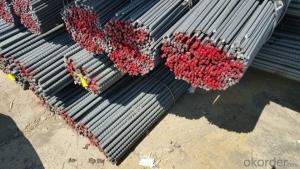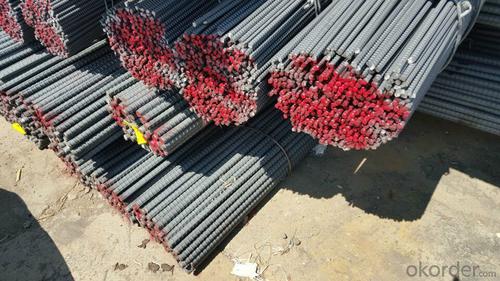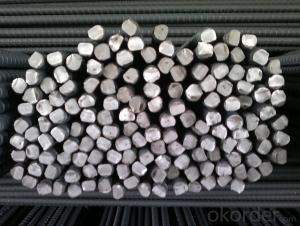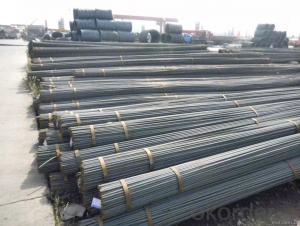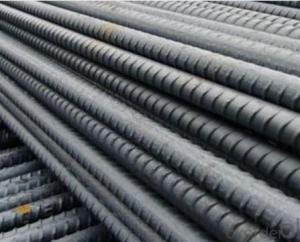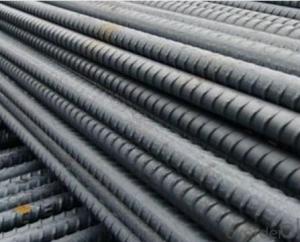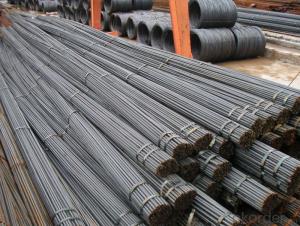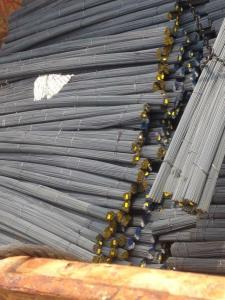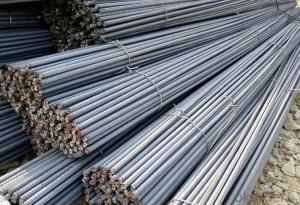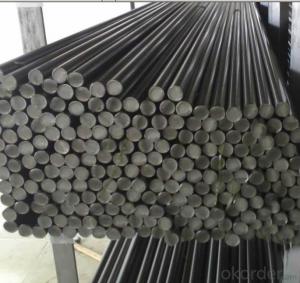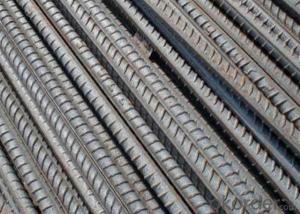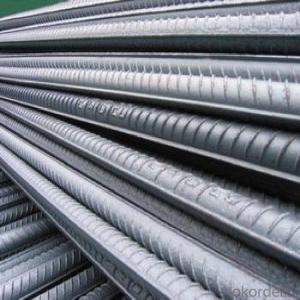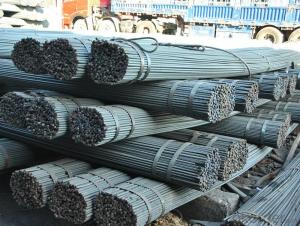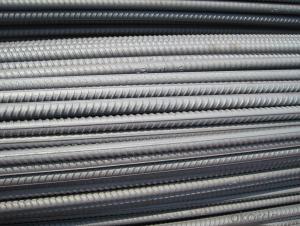Hot-Rolled HRB400 Reinforced Deformed Steel Bar
- Loading Port:
- China main port
- Payment Terms:
- TT OR LC
- Min Order Qty:
- 30 m.t.
- Supply Capability:
- 100000 m.t./month
OKorder Service Pledge
OKorder Financial Service
You Might Also Like
Specification
Product Description:
Specifications of Hot-Rolled HRB400 Reinforced Deformed Steel Bar
Standard | GB | HRB400 | |
Diameter | 6mm,8mm,10mm,12mm,14mm,16mm,18mm,20mm, 22mm,25mm,28mm,32mm,36mm,40mm,50mm | ||
Length | 6M, 9M,12M or as required | ||
Place of origin | Hebei, China mainland | ||
Advantages | exact size, regular package, chemical and mechanical properties are stable. | ||
Type | Hot rolled deformed steel bar | ||
Chemical Composition of Hot-Rolled HRB400 Reinforced Deformed Steel Bar
Grade | Technical data of the original chemical composition (%) | ||||||
C | Mn | Si | S | P | V | ||
HRB400 | ≤0.25 | ≤1.60 | ≤0.80 | ≤0.045 | ≤0.045 | 0.04-0.12 | |
Physical capability | |||||||
Yield Strength (N/cm²) | Tensile Strength (N/cm²) | Elongation (%) | |||||
≥400 | ≥570 | ≥14 | |||||
Usage and Applications of Hot-Rolled HRB400 Reinforced Deformed Steel Bar
Deformed bar is widely used in buildings, bridges, roads and other engineering construction. Big to highways, railways, bridges, culverts, tunnels, public facilities such as flood control, dam, small to housing construction, beam, column, wall and the foundation of the plate, deformed bar is an integral structure material. With the development of world economy and the vigorous development of infrastructure construction, real estate, the demand for deformed bar will be larger and larger..
Packaging & Delivery of Hot-Rolled HRB400 Reinforced Deformed Steel Bar
Packaging Detail: products are packed in bundle and then shipped by container or bulk vessel, deformed bar is usually naked strapping delivery, when storing, please pay attention to moisture proof. The performance of rust will produce adverse effect.
Each bundle weight: 2-3MT, or as required
Payment term: TT or L/C
Delivery Detail: within 45 days after received advanced payment or LC.
Label: to be specified by customer, generally, each bundle has 1-2 labels
Trade terms: FOB, CFR, CIF
Note:
1. Our products are produced according to national standard (GB), if not, supply according to national standards (GB) or agreement as customer required.
2. Other Grade and Standard Deformed Steel Bar we can supply:
Grade: GR40/GR60, G460B/B500A/B500B/B500C,BST500S
Standard: ASTM, BS, DIN
The Minimum Order Quantity of these products is high, and need to be confirmed.
3. We can not only supply Deformed Steel Bar; if you need anything about building materials, please contact us for further information.
4. Please send us your detail specifications when inquire. We will reply to you as soon as possible. We sincerely hope we can establish a long stable business relationship.
- Q: Can steel rebars be used in structures with heavy snow loads?
- Indeed, structures burdened with heavy snow loads can incorporate steel rebars. These rebars are commonly employed in construction to fortify concrete structures and augment their strength. When designing structures in regions prone to heavy snowfall, engineers carefully consider the weight of the snow and ensure that the structure is equipped to bear the additional load. Steel rebars possess the strength necessary to endure substantial loads, allowing them to reinforce the concrete within a structure and enhance its resistance against snow-induced forces. Furthermore, steel rebars aid in distributing the load evenly throughout the structure, mitigating the risk of failure or collapse. Nevertheless, it is crucial to seek guidance from a structural engineer or a knowledgeable professional familiar with local building codes and regulations to guarantee the proper design and construction of the structure to meet the specific requirements for snow loads in the area.
- Q: Are steel rebars prone to rusting?
- Yes, steel rebars are prone to rusting. Rebars are made of carbon steel, which contains iron as its primary component. When exposed to moisture and oxygen, the iron in steel rebars undergoes a chemical reaction called oxidation, resulting in the formation of iron oxide or rust. This process can be accelerated in environments with high humidity, coastal areas with saltwater exposure, or when the rebars come into contact with water or other corrosive substances. The rusting of steel rebars can weaken their structural integrity and compromise the strength and durability of concrete structures. Therefore, it is essential to protect rebars from rust by applying anti-corrosion coatings or using stainless steel rebars in areas prone to rusting. Regular maintenance and inspection can also help identify and address any rust-related issues in a timely manner.
- Q: What is the ductility of steel rebars?
- The ductility of steel rebars refers to their ability to deform and stretch without breaking during tension or bending. Steel rebars are known for their excellent ductility, which allows them to absorb and dissipate energy when subjected to high loads or seismic forces. This property is essential in construction, as it ensures that the rebars can withstand extreme conditions and maintain structural integrity. The ductility of steel rebars also makes them suitable for various applications, such as reinforcing concrete structures and providing support in buildings, bridges, and other infrastructure projects.
- Q: What are the weight and density of steel rebars?
- The weight and density of steel rebars can vary depending on the specific composition and size of the rebar. On average, a typical steel rebar has a density of around 7850 kilograms per cubic meter and weighs approximately 7.85 kilograms per meter.
- Q: How do steel rebars impact the overall flexibility of a structure?
- Steel rebars impact the overall flexibility of a structure by providing reinforcement and increasing its strength. The addition of steel rebars enhances the structural integrity, allowing the structure to withstand external forces and stresses without deformation or failure, thus improving its overall flexibility and durability.
- Q: How do steel rebars contribute to the energy efficiency of a building?
- Steel rebars contribute to the energy efficiency of a building by enhancing its structural integrity and durability. By reinforcing concrete structures, such as walls, columns, and beams, steel rebars help distribute and withstand the loads imposed on the building. This reduces the risk of structural failure and allows for the use of thinner concrete sections, which in turn saves on material and reduces the overall weight of the building. Consequently, the lighter building requires less energy for construction and transportation, and also decreases the demand on heating, cooling, and lighting systems, resulting in improved energy efficiency.
- Q: What is the recommended spacing between steel rebars in concrete slabs?
- The recommended spacing between steel rebars in concrete slabs typically ranges from 12 to 18 inches, depending on the size and thickness of the slab.
- Q: What are the guidelines for the proper curing of concrete with steel rebars?
- The guidelines for the proper curing of concrete with steel rebars are as follows: 1. Moisture: Concrete needs to be kept moist during the curing process to ensure proper hydration and strength development. However, when curing concrete with steel rebars, it is important to prevent excessive moisture as it can cause corrosion and damage the steel. Therefore, a balance should be maintained in providing enough moisture without allowing standing water to accumulate around the rebars. 2. Covering: The steel rebars should be adequately covered with concrete during the pouring process to provide protection against corrosion. The cover thickness should be in accordance with the design specifications to ensure sufficient strength and durability. 3. Curing time: The curing time for concrete with steel rebars is typically longer than that of plain concrete. This is because the steel needs to bond with the concrete and achieve proper adhesion. The recommended curing period can vary depending on factors such as ambient temperature, humidity, and the specific type of steel used. It is important to refer to the project specifications or consult with a structural engineer to determine the appropriate curing time for the specific application. 4. Temperature control: During the curing process, temperature control is crucial to ensure uniform hydration and avoid thermal stress. Rapid temperature changes can cause cracking and compromise the integrity of the concrete. It is important to protect the concrete from extreme temperature variations and provide insulation or shading as necessary. 5. Protection from external elements: Concrete with steel rebars needs to be protected from external elements that may cause damage or corrosion. This includes protecting the concrete from exposure to chloride ions, carbonation, and chemicals. Appropriate surface coatings or sealants can be applied to provide an additional layer of protection. 6. Inspection and maintenance: Regular inspection and maintenance are essential to ensure the long-term durability of concrete with steel rebars. It is important to monitor for any signs of corrosion, cracking, or deterioration and take appropriate measures to address them promptly. This may include repairing damaged areas, applying protective coatings, or implementing corrosion prevention measures. Following these guidelines will help ensure the proper curing of concrete with steel rebars, resulting in a structurally sound and durable construction material that can withstand the test of time.
- Q: Do steel rebars increase the overall weight of a structure?
- Yes, steel rebars do increase the overall weight of a structure. Rebars are typically used to reinforce concrete, providing additional strength and stability. Since steel is denser than concrete, the addition of rebars adds weight to the structure.
- Q: What are the guidelines for handling and installing steel rebars in construction sites?
- The guidelines for handling and installing steel rebars in construction sites typically include the following: 1. Storage: Steel rebars should be stored on a flat and dry surface, preferably on elevated racks to prevent contact with the ground and avoid rusting or damage. 2. Transportation: Rebars should be moved using appropriate lifting equipment, such as cranes or forklifts, to prevent excessive bending or mishandling. 3. Inspection: Rebars should be inspected for any defects, such as bends, cracks, or excessive rust, before installation. Damaged rebars should not be used. 4. Cutting and bending: Rebars should be cut and bent using appropriate tools and equipment, following the specifications and dimensions provided in the construction plans. 5. Placement: Rebars should be placed accurately and securely within the concrete structures, ensuring proper alignment and spacing as per the design requirements. 6. Tying: Rebars should be securely tied together using wire or approved tying methods at the intersections to maintain the desired positions during concrete pouring. 7. Embedment: Rebars should be properly embedded within the concrete to ensure sufficient coverage, typically complying with the minimum concrete cover specified in the design. 8. Safety: Adequate personal protective equipment (PPE), such as gloves and safety boots, should be worn by workers during rebars handling and installation to prevent injuries. It is important to note that specific construction projects and local regulations may have additional guidelines or requirements for handling and installing steel rebars. Therefore, it is crucial to refer to the project specifications and consult with relevant experts or authorities for comprehensive guidelines.
Send your message to us
Hot-Rolled HRB400 Reinforced Deformed Steel Bar
- Loading Port:
- China main port
- Payment Terms:
- TT OR LC
- Min Order Qty:
- 30 m.t.
- Supply Capability:
- 100000 m.t./month
OKorder Service Pledge
OKorder Financial Service
Similar products
Hot products
Hot Searches
Related keywords
